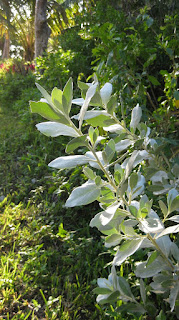" While enjoying the balmy atmosphere in the Conservatory, be sure to keep an eye open for special signs pinpointing the location of some of the Caribbean's most important plants, including the dramatic chalice vine, butterfly orchid, and Bougainvillea; delicious pineapple, coconut, mango, banana, chocolate, and vanilla; and plants with delightful names like ice cream bean, flamingo flower, Panama hat palm, lipstick tree, and autograph tree."
This should be so interesting to visit and compare the plants we see there with the ones we find in the Abacos. Of the ones mentioned above, we already have Bougainvillea, coconut and banana in our yard. Here are some additional examples of the plants we have in our yard that I hope to identify when visiting the upcoming Caribbean Garden show of the NYBG
First, is this lovely palm tree that has started spontaneously in our yard.
 |
| . |
Here is another self starter that gets a lovely white orchid-like flower when it is in bloom. The grass is only about 4 to 5 inches high. When I find one in bloom I will add it to this site.
And may I introduce you to our baby fig tree?
Our fig tree is now three years old, and just starting to take hold. .
People around here call the one above the "Life Leaf". It has a lovely white flower when it is in bloom and is a delicate plant that grows around the edges between the "bush" and the "yard".
This last tree below is called by many the"Madeira Olive" tree. But when I look up the "Madeira" Tree, I do not see this kind of leaf and also, the "olive" on this tree is much smaller than the one shown in the book for a Madeira. The parrots love the olive from this tree. Last year, on one of our larger trees of this kind, we found over 50 parrots all hanging on the tree, eating the "olives".
Here is another interesting native plant.
We call the one above a "Silver Button", and it is expected to reach a maximum height of about 15 or 20 feet.
The one above is called a "Wild Hibiscus". It has pretty small red flowers.
The two examples below are from very small, bushy trees that provide berries popular with the birds in our area.
And may I introduce you to our baby fig tree?
Our fig tree is now three years old, and just starting to take hold. .
People around here call the one above the "Life Leaf". It has a lovely white flower when it is in bloom and is a delicate plant that grows around the edges between the "bush" and the "yard".
This last tree below is called by many the"Madeira Olive" tree. But when I look up the "Madeira" Tree, I do not see this kind of leaf and also, the "olive" on this tree is much smaller than the one shown in the book for a Madeira. The parrots love the olive from this tree. Last year, on one of our larger trees of this kind, we found over 50 parrots all hanging on the tree, eating the "olives".
I must confess that I lack a lot of knowledge about the plants in my yard down here, but hope to become much more knowledgeable about them in 2011.









Mary
ReplyDeleteBasically the NY Botanic Garden is fantastic. We spent many happy hours there in 05-06. I am sure their Caribbean show will be extraordinary.
Re your plant ID issue. When we lived in Tanzania we started a garden,burying food scraps to provide humus. All these weeds began to appear. Then a Maasai friend explained they were actually papayas: 18 months later we were eating home grown fruit!
Martin
Funny that you should mention that. I forgot to write about our papaya trees. We had papaya in our fruit salad last evening, from a papaya tree that sprouted in our compost are. The fruit was perfectly ripe and it was delicious!
ReplyDeleteMany people down here argue that the male plants should be removed because they do not yield fruit. But I find that the male plants have small flowers on them that open up at night and smell like jasmine. The male plants also provide soft shade to the garden on sunny hot days. I intend to keep both sexes of papaya plants growing in the back yard.